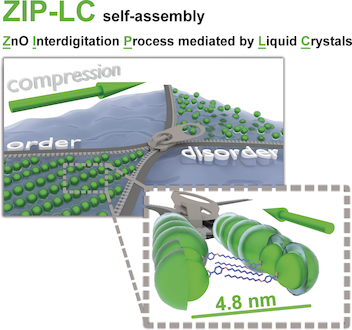Jan Paczesny,a Małgorzata Wolska-Pietkiewicz,b Ilona Binkiewicz,a Zbigniew Wróbel,a Monika Wadowska,b Kinga Matuła,a Igor Dzięcielewski,c Damian Pociecha,c Julita Smalc-Koziorowska,c Janusz Lewiński,ab Robert Hołysta
a Institute of Physical Chemistry, Polish Academy of Sciences, Kasprzaka 44/52, 01-224 Warsaw, Poland
b Faculty of Chemistry, Warsaw University of Technology, Noakowskiego 3, 00-664 Warsaw, Poland
c Institute of High Pressure Science, Polish Academy of Sciences, Sokołowska 29, 01-142 Warsaw, Poland
DOI: 10.1002/chem.201502714.
First published online 2 Oct 2015.
The ability to self-assemble nanosized ligand-stabilized metal oxide or semiconductor materials offers an intriguing route to engineer nanomaterials with new tailored properties from the disparate components. We describe a novel one-pot two-step organometallic approach to prepare ZnO nanocrystals (NCs) coated with deprotonated 4-(dodecyloxy)benzoic acid (i.e., an X-type liquid-crystalline ligand) as a model LC system (termed ZnO-LC1 NCs). Langmuir and Langmuir–Blodgett films of the resulting hybrids are investigated. The observed behavior of the ZnO NCs at the air/water interface is rationalized by invoking a ZnO-interdigitation process mediated by the anchored liquid-crystalline shell. The ordered superstructures form according to mechanism based on a ZnO-interdigitation process mediated by liquid crystals (termed ZIP-LC). The external and directed force applied upon compression at the air/water interface and the packing of the ligands that stabilize the ZnO cores drives the formation of nanorods of ordered internal structure. To study the process in detail, we follow a nontraditional protocol of thin-film investigation. We collect the films from the air/water interface in powder form (
